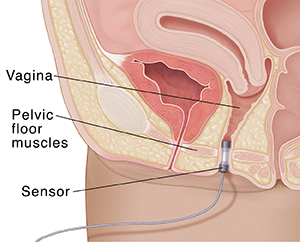Treating Incontinence in Women: Special Therapies
Your healthcare provider will discuss your choices for treating your urinary incontinence. These depend on the cause of your problem and any other health issues you have. Often behavioral changes are tried first, followed by various medicines. If these methods are unsuccessful, 1 or more of the therapies described below may be part of your treatment plan.
Biofeedback
This method is taught by a nurse or physical therapist. During the therapy, a small sensor is placed in your vagina or rectum. Another sensor is placed on your stomach. Other types of sensors are also available. These sensors read signals from the pelvic floor muscles. When you contract or relax your muscles, these signals are shown as images on a computer screen. Using the images, you can learn to relax or contract certain muscles. This can help you strengthen and better control these muscles. And it can help you learn pelvic floor muscle exercises.
 |
| During biofeedback, sensors send signals from your pelvic floor muscles to a computer screen. |
Electrical stimulation
This is a painless therapy that uses a tiny amount of electric current. It helps strengthen very weak or damaged pelvic floor muscles. The electric current is sent through the muscles of the pelvic floor and bladder. This causes the muscles to contract. In time, this helps make the muscles stronger.
Stimulator implants
This method is used to treat urge incontinence. A small device is implanted under the skin near the upper buttocks. This device gives off mild electrical signals. These block extra signals that are being sent to the bladder muscle. This helps the bladder work more normally.
Online Medical Reviewer:
Donna Freeborn PhD CNM FNP
Online Medical Reviewer:
Marc Greenstein MD
Online Medical Reviewer:
Raymond Kent Turley BSN MSN RN
Date Last Reviewed:
7/1/2022
© 2000-2024 The StayWell Company, LLC. All rights reserved. This information is not intended as a substitute for professional medical care. Always follow your healthcare professional's instructions.